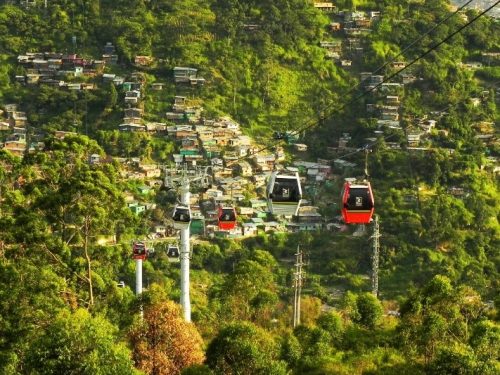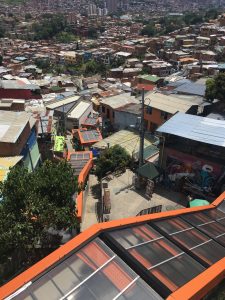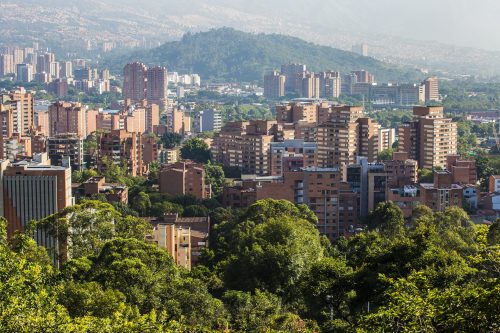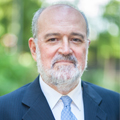Last week, from October 15 to 21, Barcelona’s City Council organized the first “Open City Biennial of Thought” (“Ciutat Oberta Biennal de pensament”), with the aim to “link the debate on the role of today’s cities with the big challenges facing contemporary society.” More than 20,000 people participated in 69 activities, including talks, debates and conferences in topics ranging from inequality, gentrification and exclusion, to innovation and creativity. As part of the Biennial, a CIDOB Breakfast with Sergio Fajardo, former Mayor of Medellín (2004-2007) was organized.
Here at IESE Cities in Motion we are developing a case study on the transformation of the city of Medellín, whose provisional title is Medellín’s Transformation: Toward a More Equitable, Innovative and Participatory Urban Society (Ricart, Berrone, Duch). The city of Medellín, Colombia, is often considered a success story and an international benchmark for urban transformation and social innovation. Once considered the “Murder Capital of the World”, by the end of last century, the Colombian city had very high levels of poverty, inequality and social exclusion. However, in only two decades, Medellín has managed to transform itself into a safer, more inclusive and prosperous place that receives international attention and recognition, such as being named “the world’s most innovative city” in 2012 or winning the prestigious Lee Kuan Yew World City Prize in 2016, for its sustainable urban design.

Key ingredients for the city’s transformation
By the late 1990s and the beginning of 2000s, some early signs of transformation emerged in the city, such as the opening of Metro de Medellín in 1995 – the first and only subway network in Colombia. However, many people consider the election of Sergio Fajardo in 2003 as the tipping point for the city’s real transformation. During last week’s debate in Barcelona, Fajardo highlighted some of the elements that were key in achieving such transformation.
Connectivity
Actions and initiatives to enhance connectivity, both from the point of view of physical connectivity and by giving excluded people competences, have been critical to reduce poverty and inequality and increase social inclusion.

First, in terms of physical connectivity, urban projects such as the Medellín Metrocable – the world’s first cable car system for public transport designed to integrate the city’s low-income residents living in the poorest neighborhoods, which clung to the valley’s sides, with Medellín’s wealthier commercial center -; or the San Javier outdoor escalators – public outdoor escalators built to connect one of the poorest and most violent neighborhoods on steep hills to the city center -, are probably two of the most well-known examples of Medellín’s urban transformations.
With these simple innovative transformations of the urban public space, it was possible to break down the isolation of some of the poorest areas and enhance equity and justice at the same time.
Education
Additionally, giving people competences and skills to be able to reduce social and economic gaps has been essential in the city’s makeover. The idea that education drives change and that it can be a powerful tool for reducing inequalities has been at the core of Fajardo’s administration policies, both as Mayor of Medellín and as Governor of Antioquia. Programs such as “Medellín, la más educada” (“Medellín, the most educated”), a public program started during Fajardo’s administration (2004-2007) and continued by his successor, Mayor Alonso Salazar (2008-2011), aimed at the use of education – especially early childhood and primary education – as a means to reduce poverty and inequality and to fully harness the potential of people and communities.

Medellín has become an inspiration for urban transformation around the world, especially for cities in developing countries with high levels of inequality and exclusion. The city has succeed in increasing social, economic and territorial inclusion by, among others, focusing on the improvement of public spaces, enhancing physical connectivity, and expanding education. Most certainly, the city still faces important challenges in terms of poverty, inequality and social inclusion. Nonetheless, Medellín’s remarkable progress also offers a positive example of urban transformation with social innovation at the heart of its change.
Have you ever been to Medellín? Let us know your thoughts on the comments section below!




This is so inspiring and best transformation I’ve ever seen.
Hello,
Thank you for these useful information.
hi Ana,
that is a great article. thanks for sharing.
Medellin is an example of a city with a great urban transformation. I visited the city in October 2018 and was amazed to find a cable car being used for transport transport. The integration of various modes transport from NMT facilities, bus, tram, train and cable cable made traveling very effective and efficient.
My husband and I visited Medellin in December, 2018 and we were absolutely enthralled to witness the changes that are described in this article. We particularly enjoy the arts so we absolutely loved Botero park and all of his sculptures. It was so joyous there as everyone was enjoying the sculptures! And we adored the graffiti tour that we took on the mountain where there was stunning artwork at every turn and within the environment of the people. The paint is donated to the people to transform their own neighborhoods,,,fantastic! *Our main objective was to enjoy the Christmas lights which were stunning. The symbolism was clear, light overcomes the darkness. We were buoyed with hope for our own country (USA) that profound positive changes for everyone CAN occur with devoted and nurturing LEADERSHIP!
Hi, Excellent tutorial article. I love to read it
Thank you for such precise description of what my hometown has gone through and its vision to continue improving life quality for its people. I was looking at concise descriptions of Medellín to present it to people from other country and yours has a very good approach, that I particularly found valuable, as it provides a transformational approach of the city’s recent history.
Outstanding tale. I enjoyed reading and picked up a lot of new information.
Thank you so much for sharing this awesome
Thank you, this is great information! The approaches used, including improving physical connectivity and providing education to residents, demonstrate the importance of community integration and individual empowerment in inclusive city development.